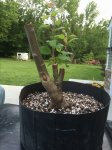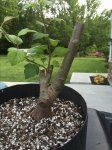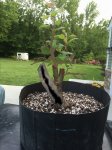Well, you've already done it, so I'll wish you good luck.
But, this is the wrong time of year to be barerooting deciduous trees.
My advice would have been to not do anything until next spring. Then bare root it, and build a grow box for it. And chop it however you like. That way you could make a flat root ball. The shape of the box I would suggest would be wider than the plastic can its it, and about half as deep.
The idea is to get the roots to spread out wide, rather than down.
Now, to the next point: Smoke is probably right. It appears to be grafted, and you're cutting the grafted part off. Which leaves you with the base under stock. Which is... Who knows? It's unlikely to have good characteristics for bonsai. Maybe you'll get lucky.
The catch-22 got those new to bonsai is learning how to choose appropriate material. It takes experience. And newbies don't have any experience.
But, you're getting some now!



